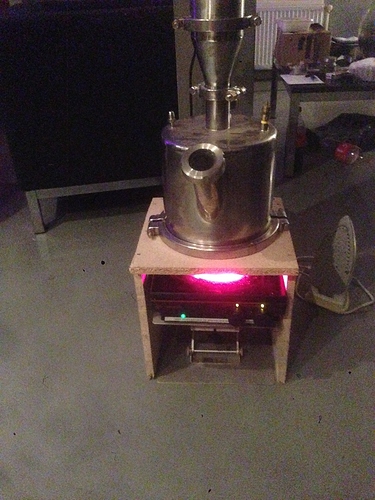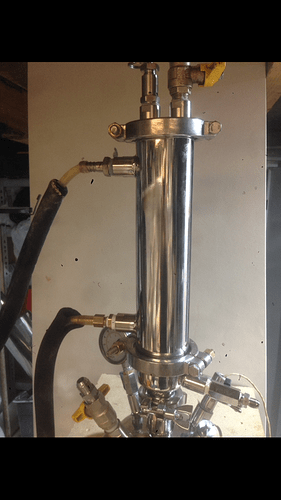That’s treu I don t think the volume gets affected by such low pressures
Well I guess is only the ability to administer more heat to the reaction
Often a catalyst on it s own for reactions
Sorry didn’t see the second half of your reply…
Ya lost me a little with that methanol bit - you would be RAISING boiling point when you raise pressure. I assume that’s what you were saying.
It’s not really apples to apples comparing methanol (polar protic) to heptane (nonpolar aprotic). But I might have missed your point in which case I apologize.
As somewhat of an aside, I generally try not to move in the direction of pressurizing a reaction that I can get to proceed under more mild conditions. The research you’re doing is interesting in that I myself don’t know anyone else attempting this. But either way, pressurized reactions generally trend in the direction of less safe or more expensive on scale.
That’s right, it’s about either supplying the energy necessary to get over some activation threshold (adding heat) or by creating some scenario which lowers that activation energy (a catalyst). You can visit the NIST Webbook and see a bunch of solvent thermal properties at various conditions (like the boiling point and density of heptane at 160 psig).
Methanol at 90 was just an example of how hard it can be pushed
Not a comparison to the reaction with heptane
I do some research in the bp under pressure but there is many variabals such as the inert gas the reaction by products etc so for now I place trust in the prv s for the discripancy is quit large
Yes, @eyeworm and @Roguelab ! When you see an equilibrium between reactants (CBD) and products (THC), and/or more than 1 different product (D8 & D9), you know you are generally dealing with a 2nd Order reaction mechanism. That means the concentrations of products (aka: reaction “kinetics”) affect the procession of the rxn. Any time you are in 2nd Order, pressure will affect the outcome. In this case, pressure increases the energy of the reactants; they vibrate and bump into each other more often. This is especially true in gas phase and right at the liquid/gas interface, when their energy is at its peak… there are statistically more reactant and catalyst interactions with higher pressure.
We need to get you on an educational show, you explain these things so well and with such clarity
Haha no kidding.
“GLG TV with your host Photon Noir”
@Killa12345 thats a second time I am right!!! He did the exact same design, steel pressure vessel with a glass reaction vessel inside
Great stuff Roguelab.
Anyone have thoughts or idea’s on a internal agitator w/triclamp connection?
Use a magnet plate heater you’ll be surprised how well they work
For those that wonder
You can place the Ss pars in an oven to dry out but a heat gun or 2 and a slow inert gas stream or vacuum running
Does a pretty good job to
Placing a coldtrap you collect 5 drops of water on a 10" pot with a 4" tube
More than I expected 0.32 gr of water
![]() The things we do when corona keeps us home
The things we do when corona keeps us home
Pardon my naivete, wouldn’t it be easier to avoid all that pressure
and use another solvent allowing a homogenous reaction instead
of a stirred suspension in alkanes ?
For instance, some lewis acid catalysts are quite soluble in certain
(mostly inert) solvents, which should speed up your reaction quite
nicely.
So the magnet plate heater died by the weight of the cls solved it with a
“Tabel” for the cls and the magnet plate heater on a lab Jack this way the cls it s weight is not pushing on the magnet stirrer😉
Up next is finding way s to dry out all compounds without getting air involved when transfering
So heptane in a bottle with 4a sieves
With a hose to the cls
Mol sieves dried in the cls when placed in oven to dry
Reagent X dryied in vac oven then placed in a jacketed heatedtube under vacuum
All administered to the cls by hose
Using vacuum or inert gas pressure to get it in
Then run the reaction
Cbd > D9
Hope to beat the last personal record
At least no D8
New little rig trying to figure out if
( fu&$@ I love triclamp )
An inert gas can be skipped al along on dry reactions
Hotplate set temp is 220C
Heptane in the pot
Trying to figure out how hot
Hot plate needs to be set at to reach 90 psi only on heptane vapor with the reflux on the chiller to calculate btu
Etc
How bigs your reflux pot?
I have several now a shatterplater 6"
A 10" long welded base 6"
The galaxy wich is 10" diameter
And a 12"x24" collection pot
So enough options for now
I run mostly small reactions /amounts
For I yust throw something in the pot and see what happens
Isomerization wise
Done over 37 acids in pure form already and often I end up throwing in the trash if the results are not interesting 7 kg if isollate has left the building so far in the trash can ![]()
So must runs are 100 gr runs with solvent and chemicals no more than 1 liter volume
Hey Roguelab I have a question. The same SOP that uses AC in solvent refluxed under pressure or p-tsa, zncl2, hcl? At what ratio?
What ratio of cbd distillate to solvent do you use?
Thanks!

